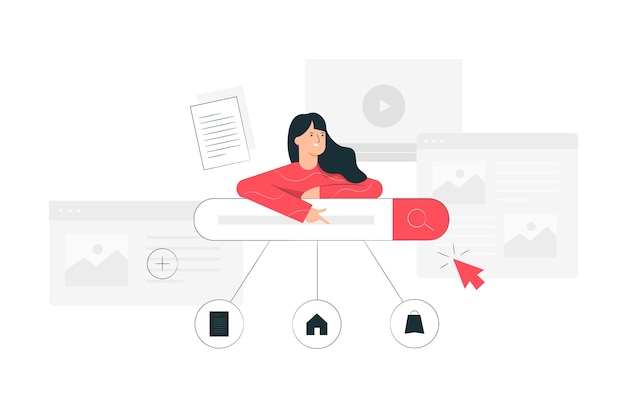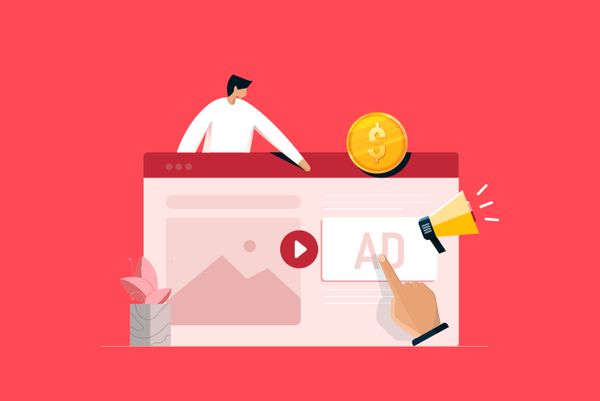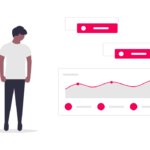Pay Per Click advertising is a key component of online advertising. PPC marketing lets you place paid ads on search engines and social media. Your ads will pop up based on a potential customer’s search activity.
Your PPC campaign can be used to boost organic SEO placement, drive sales, or advertise new services while reaching out to consumers most likely to be converted.
Pay Per Click advertising can be a complicated subject, but we’re going to run through everything you need to be a master of PPC advertising.
What is PPC Advertising?
PPC advertising is essentially paying a search engine or social media platform to place your ad above the organic search results. This gives you better placement and increases the odds that someone will engage with your marketing.
A good example of PPC advertising is the ad boxes that are displayed on top of Google search results.
They are attractive to consumers because they are related to the search query, and they seem to be part of the search results rather than being obviously paid advertisements.
Both these factors can drive up engagement more effectively than traditional ad banners.
The main benefits of PPC marketing are:
- It appears to consumers with matching queries or target demographics.
- It displays your ads to viewers with the highest chances of conversion.
- It enables you to maximize your ad spend by only paying for clicks instead of views.
Your PPC campaign will be charged a fee that is based on how often users engage with the ad, how competitive your keywords are, and how the search engine assesses your PPC ads—don’t worry; we’ll cover the costs in detail later on!
Pay Per Click advertising has gone through a lot of changes in the last few years, but it’s still the beating heart of online marketing. Even Google makes a staggering 97% of its revenue through marketing on Google Ads.
Let’s find out how your company can get in on this market.
SEO vs. PPC
SEO stands for Search Engine Optimization. This is the use of keywords and other strategies to help put your web page at the top of search engine results.
Pay-per-click marketing automatically puts your website at the top of the search results for the keywords you’re targeting. SEO builds an organic online presence that always remains at the top while pay-per-click marketing is a way to jump to the top of the list for a small fee.
PPC vs. CPC
Pay-per-click is the marketing strategy, while CPC, also known as cost-per-click, is the amount of money that your brand is going to spend on this advertising.
Read more: Best PPC Ad Networks (Top 12)
Understanding PPC Advertising Terms
You’ll find a lot of jargon and industry-specific terminology in the world of PPC advertising. We’ll cover a few of the most common terms, so you can chat like a marketing pro.
- SERP—A Search Engine Results Page is where your PPC advertising is going to be displayed. The best place to be is the first page of results on search engines like Google and Yahoo.
- SEM—Search Engine Marketing is the bigger picture where PPC marketing plays a major role. SEM also includes organic website placement.
- CPC—This is the Cost Per Click. This is what your company pays for PPC advertising. It’s determined based on a simple equation:
Competitor’s Ad Rank / Your Ad’s Quality Score + 0.01 = CPC
- Ad Rank—This is where your ad gets placed on a results page. An equation also defines it: Maximum Bid x Quality Score.
- Maximum Bid—This is the highest amount your business would be willing to pay for a Pay Per Click advertising.
- Quality Score—This is a score that search engines assign your ad based on how often people click on it (the Click Through Rate or CTR) compared against ads with similar keywords.
- Campaign—This is the heart of your Pay Per Click advertising. You can think about this as the goals your business has set up for your PPC marketing.
Read more: 7 Quick Tips for Optimizing Your Google AdSense Campaign
Getting Starting With PPC Advertising Platforms
PPC advertising is hosted and managed through an advertising platform. These are where your PPC campaign will be hosted and get all of its attention and clicks. Here’s a rundown of a few of the biggest PPC marketing platforms.
- Google Ads—Formerly called “AdWords,” Google Ads is the biggest name in online advertising. Google gets about 90,000 searches every second.
- Facebook Ads—Facebook Ads are a type of platform marketing that has greater demographic targeting than Google Ads. These ads specifically reach users of Facebook social media sites. You can leverage Facebook ads reporting tools to monitor these ads performance.
- Bing Ads—Bing is a popular alternative to Google that typically features cheaper pricing options but with a much smaller audience size.
You’ve also got countless other options when it comes to finding the best PPC marketing platform for your business. It’s important to keep in mind that Google drove 95% of all PPC clicks while competitors like Bing only accounted for 3%.
How to Build Your PPC Campaign
There are a few things you need to consider when building your PPC strategy. Here’s a quick rundown with a few bigger-picture points.
- Set Parameters—This should include who you’re targeting and what you’re advertising for
- Set Your Goals—These goals should be measurable and trackable.
- Pick the Right Ad Type—The right PPC ads for your strategy could be part of a SERP strategy based on Bing, a platform ad push on Facebook, or another strategy that helps your brand reach those trackable goals.
- Do Keyword Research—What keywords and phrases are you targeting? You should analyze your competition as well as any geographic or demographic-specific keywords.
- PPC Ad Copy—What will your PPC ads say? Ad copy can make or break your conversions.
- Landing Page Best Practices—Once customers click on your ad, where will they go? Your landing page needs to be optimized across devices, integrated into your marketing funnels, and designed to facilitate a sale.
- A/B Testing Your PPC Ads—Always launch your ads with an A/B testing plan in mind. This means launching two slightly different ads and testing to see which one works best. This helps to refine your overall marketing.
- Conversion Tracking—Your business should be poised to track relevant information about conversions, including which ads they clicked, how they reached your page and their spending habits
- Launch Your Strategy—Once you’ve walked through these steps, you’ve got to launch your strategy to start seeing results.
You also need to come up with your budget for your PPC advertising. Legal keywords are some of the most expensive, with finance coming up as a close second, but where your keywords fall will shape how much you need to set aside for Pay Per Click advertising.
A good practice is to capitalize on lesser-known keywords that may be ignored by your competitors. Instead of wasting advertising dollars trying to bid for the hottest keywords, do a little homework and research more obscure search terms that are relevant to your product or service but which still attract a considerable amount of search traffic.
Google even has a detailed guide to how they price PPC marketing and how you can budget a PPC campaign.

How to Optimize Your Pay-Per-Click Advertising
You’ll need to refine and adjust your PPC campaign over time. You’ll be building knowledge while you advertise, and you can leverage that to improve your conversions.
Here are the top 22 tips for PPC advertising optimization that can help you out.
1. Higher ad relevance
A key to optimizing your PPC advertising strategy is to make sure you have high ad relevance. This ensures that the keywords your potential customers are searching for are the ones targeted by your PPC marketing.
2. Use relevant and specific keywords
Ensure your target keywords are relevant to your business and specific enough to attract qualified traffic.
3. Use negative keywords
Adding negative keywords to your campaigns can help you avoid getting irrelevant clicks and improve your overall ad spend efficiency.
4. Use long-tail keywords
Long-tail keywords are more specific and tend to have a lower cost-per-click, which can help you get more qualified traffic at a lower cost.
5. Test different ad copy
Experiment with different ad copy to see which versions perform the best.
6. Test different landing pages
Try testing different landing pages to see which ones result in the highest conversion rate.
7. Use ad extensions
Ad extensions can give your ads a competitive edge and provide more information to potential customers.
8. Use remarketing
Remarketing allows you to show ads to users who have previously visited your website, which can be an effective way to bring them back to make a purchase.
9. Monitor and adjust your bid prices
Keep an eye on your bid prices and adjust them as needed to get the best return on your ad spend.
10. Use conversion tracking
Setting up conversion tracking allows you to see which of your ads result in conversions, so you can focus on the campaigns performing best.
11. Regularly review and optimize your campaigns
Make sure to regularly review and optimize your campaigns to ensure that you get the best results possible.
12. Know what your customers want to see
Google holds an astounding 29% of the global ad budget. You want to make sure your ads are phrased in a way that engages your core demographics. This means knowing what they want to see rather than just what you want to show them.
Maintaining Your PPC Marketing
A key factor in maintaining a PPC campaign is Knowledge Management. Your marketing team will be generating a lot of data while you run your PPC campaign, but how do you make sure that is not a wasted effort?
You need to learn the basics of the Knowledge Management process to ensure that not only is your campaign successful but you also generate additional value by capitalizing on the knowledge gained during this PPC advertising campaign.
Your marketing team also needs to be ready to change. There are some big shake-ups coming in the near future for online ad platforms. This includes the end of cookies, new privacy laws, and bigger changes to how we advertise online.
Finally, it should be noted that PPC advertising is only one aspect of online advertising. For long-term results, it should be combined with good SEO, organic search, and good old-fashioned tactics like engaging content and social media campaigns.
While PPC marketing can bring lots of eyeballs over the campaign period, it can be expensive if you rely on this type of advertising exclusively and bring only short-term benefits. The idea is to sustain consumer interest and brand engagement by combining PPC advertising with other marketing tactics.

Why Choose PPC Advertising?
PPC advertising has some powerful advantages for modern businesses. With PPC campaigns, you can target your audience directly, allowing you to be more precise when it comes to marketing.
Here are some more reasons why PPC is the king of modern advertising.
- PPC ads are flexible and can be changed
- They are very easy to track and measure
- PPC can be connected to other strategies like email marketing
- Impressive ROI if done right
- PPC maximizes ad budget by reaching only the right audience
Key PPC Marketing Takeaways
- PPC advertising can be a complex subject, but you’ve not got all the tools you need to launch your new PPC campaign. Remember the basics, and you’ll be good to go!
- PPC plays an important role not just in conversions, but in building organic SEO placement
- Build your PPC marketing strategy by aiming at concrete, trackable goals
- Optimize your PPC strategy by refining your analytics and using A/B testing
- Knowledge management helps you retain and utilize the information your brand gathers through this marketing
- PPC ads are flexible and can scale to meet the needs of your brand
PPC Advertising FAQs
Pay-per-click (PPC) advertising is a form of paid advertising that puts your website at the top of search engine results. This type of Search Engine Marketing (SEM) only charges advertisers when a user clicks on your ads.
There are five key benefits of using PPC marketing:
1. PPC ads are cost-effective.
2. PPC advertising generates results faster than organic search.
3. These ads allow marketers to target their ideal customers.
4. PPC ads help websites rank in SERP despite low domain ratings.
5. PPC ads data can improve a publisher’s SEO strategy.
A common example of PPC advertising is Google AdWords. Advertisers create ads and bid on specific keywords.
These ads are displayed in the sponsored results section of Google’s search results page when a user searches for those keywords. The advertiser is then charged a fee each time someone clicks on one of their ads.

Shubham is a digital marketer with rich experience working in the advertisement technology industry. He has vast experience in the programmatic industry, driving business strategy and scaling functions including but not limited to growth and marketing, Operations, process optimization, and Sales.




![CTV vs OTT Advertising: Which one is Right Pick for Publishers? + [6 Bonus Strategies] Ott vs Ctv](png/featured-image-270x180.png)


